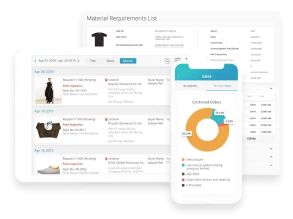Exploring the 7 key benefits of ERP in textile manufacturing
Introduction
The rhythmic clatter of fabric looms and the hum of spinning machines are the pulse of the multi-billion-dollar fashion industry.
In fact, textile have been the heart of craftsmanship and creative expression for centuries. But industrialization, globalization and consumer demand have pushed the textile sector to consistently find ways to improve efficiency, reduce costs, and quickly adapt to market changes. The industry has done through the embrace of modern technologies, cutting-edge machinery and data-driven systems.
One key tool in the future-ready textile manufacturer’s arsenal is Enterprise Resource Planning (ERP) software. So, what is Textile ERP? Enterprise Resource Planning for textiles is a digital lodestar that seamlessly integrates various processes and departments—from dyeing and procurement to spinning and sales—intertwining disparate strands of information to enhance visibility and improve coordination.
In this blog post, we will discuss the importance of ERP in the textile industry, provide an overview of WFX ERP for the textile industry, and highlight the numerous benefits that textile manufacturing businesses can gain from implementing an ERP solution.
Benefits of Textile ERP for manufacturing businesses

Textile ERP’s impact extends beyond factory walls, revolutionizing the entire supply chain, across suppliers, distributors, and buyers. More than a mere tool, ERP has become a catalyst for cultural transformation, fostering collaboration and uniting the industry under a shared purpose. With ERP’s guiding presence, the textile industry sets sail on a course toward a future where craftsmanship and technology seamlessly coexist.
Let’s dive into some Textile ERP’s most important benefits:
1. Improved Operational Efficiency
Streamlining operations and increasing productivity are key benefits of implementing an ERP system in textile manufacturing businesses, which include:
- Reduction in operational costs: By automating manual tasks and streamlining business processes, ERP software can help textile manufacturers reduce operational costs and improve overall efficiency.
- Enhanced communication and collaboration: ERP systems enable better communication and collaboration between departments, suppliers, and customers, leading to improved coordination and faster decision-making.
- Automation of manual tasks: With ERP software, textile manufacturers can automate time-consuming manual tasks, freeing up staff to focus on more strategic activities.
2. Enhanced Business Reporting and Decision Making
ERP systems provide comprehensive data and reporting tools that improve decision-making processes in textile manufacturing businesses, as seen through the following aspects:
- Real-time information and reporting tools: ERP systems provide real-time information and advanced reporting tools that enable textile manufacturers to make informed decisions based on accurate data.
- Single integrated database for all business processes: By consolidating all business data into a single, integrated database, ERP software provides a comprehensive view of the entire organization, making it easier to identify trends, issues, and opportunities.
- Informed decision making: With access to real-time data and advanced reporting tools, textile manufacturers can make informed decisions that drive growth and profitability.
3. Improved Customer Service
Textile manufacturers can significantly enhance their customer service by adopting ERP systems, which offer advantages such as:
- Better access to customer information: ERP systems provide textile manufacturers with easy access to comprehensive customer information, enabling them to better understand their customers’ needs and preferences.
- Faster response times: With real-time access to customer data, textile manufacturers can respond more quickly to customer inquiries, orders, and issues.
- Improved on-time delivery: ERP software helps textile manufacturers optimize their production and distribution processes, resulting in improved on-time delivery rates.
- Increased order accuracy: By automating order processing and reducing manual errors, ERP systems can help textile manufacturers increase order accuracy and reduce costly returns.
4. Optimized Inventory Costs
Effective inventory management is crucial for textile manufacturers, and ERP systems help optimize inventory costs through features like:
- Proper inventory management: ERP software enables textile manufacturers to effectively manage their inventory levels, ensuring that they have the right amount of stock on hand to meet customer demand.
- Avoiding too much or too little inventory: With better inventory management, textile manufacturers can avoid the costs associated with holding too much or too little inventory.
- Reducing overhead costs and customer fulfillment times: By optimizing inventory levels, textile manufacturers can reduce overhead costs and improve customer fulfillment times.
5. Cost Savings and Increased Profitability
Implementing an ERP system can lead to substantial cost savings and increased profitability for textile manufacturing businesses, as demonstrated by these benefits:
- Better resource allocation: ERP systems help textile manufacturers allocate resources more effectively, ensuring that they are used in the most efficient and profitable manner.
- Streamlined business processes: By automating and streamlining business processes, ERP software can help textile manufacturers reduce costs and increase profitability.
- Improved vendor relationship management: ERP systems enable textile manufacturers to better manage their relationships with suppliers, leading to cost savings and improved product quality.
- Increased efficiency: With improved operational efficiency, textile manufacturers can reduce costs and increase profitability.
6. Better Data & Cloud Security
Data and cloud security are of paramount importance in today’s digital world, and ERP systems ensure robust protection through measures such as:
- Dedicated security resources: ERP providers typically have dedicated security resources to ensure that their systems are protected against threats and vulnerabilities.
- Protection against malicious software: ERP systems offer robust protection against malware and other malicious software, helping to safeguard sensitive business data.
- Data distribution across multiple servers: By distributing data across multiple servers, ERP systems can ensure that data is always available and secure.
7. Supply Chain Management and Collaboration
ERP systems enhance supply chain management and collaboration in textile manufacturing businesses, resulting in benefits like:
- Effective demand forecasting and lean inventory: ERP systems enable textile manufacturers to effectively forecast demand and maintain lean inventory levels, reducing waste and improving efficiency.
- Reducing production bottlenecks: By providing real-time visibility into production processes, ERP software can help textile manufacturers identify and address bottlenecks, improving overall production efficiency.
- Increased transparency throughout the business: ERP systems provide increased transparency throughout the entire business, making it easier for textile manufacturers to collaborate with suppliers, customers, and other stakeholders.
Conclusion
Textile ERP is not just a tool; it is a catalyst for growth, driving manufacturing businesses toward unparalleled success. As the industry continues to evolve, those who embrace this technology will find themselves at the forefront of progress, weaving a future that is both prosperous and enduring.
WFX Textile ERP empowers businesses to make informed decisions in real-time, providing valuable insights into their own business as well as the performance of their vendors. This newfound visibility enables manufacturers to respond swiftly to market demands, anticipate trends, and optimize resource allocation.
As manufacturers embrace Textile ERP, they are not just investing in technology but setting the stage for long-term growth and profitability. To experience the transformative power of ERP in the textile industry, sign up for a demo of WFX ERP today!








